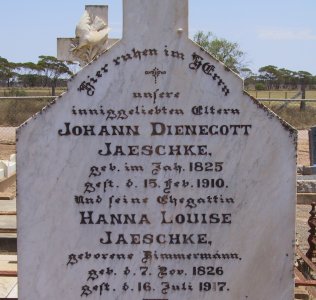![]()
Quick-thinking Dienegott!
At the age of 14, Johann Dienegott Jaeschke was the youngest of the six Jaeschke children to arrive in South Australia with Johann Georg Jaeschke and his second wife. Originally from Scharkewald-Hauland in the Prussian province of Posen, they reached Port Adelaide on the Catharina around the 25th January 1839. The family lived at Hahndorf; as one of the founding settlers, Johann Georg Jaeschke is one of the 52 names on the gates of the Pioneer Gardens in Hahndorf.
![]()
 When
Dienegott married Johanne Luise Zimmermann on 17th April 1847 he built a pug-and-timber
cottage and owned a few animals and a few pieces of farming equipment. Johanne,
born at Jehser in the Prussian province of Brandenburg, had arrived in South
Australia on the Zebra.
When
Dienegott married Johanne Luise Zimmermann on 17th April 1847 he built a pug-and-timber
cottage and owned a few animals and a few pieces of farming equipment. Johanne,
born at Jehser in the Prussian province of Brandenburg, had arrived in South
Australia on the Zebra.
Dienegott and his wife worked long and hard but did not seem to make much headway. Then, one day he heard about the discovery of gold in the neighbouring colony of Victoria at places called Forest Creek (between today's Castlemaine and Chewton) and Bendigo Creek.
To Dienegott it was exciting news and he was determined to try his luck there. Who knows - it might solve all their problems! So, saying goodbye to his wife and leaving her to keep things going at home, he saddled up his poor old horse Rosinante, packed his saddlebags and with a shovel strapped to his side, set off on the long, lonely ride to Forest Creek and Bendigo.
He camped at night by the roadside wrapped in an old overcoat and horse-rug, with Rosinante tethered close by. Life, he found, was hard at the diggings. He lived on smoked meat and damper but didn't complain, because he was finding gold!
When he felt he had stored away enough gold in his belt to buy all those things they needed, he set off for home - and with a much fatter Rosinante!
One day, however, as he was trotting westward, dreaming of what he would do with all the gold he had found, his dreams were suddenly shattered - from some bushes at the side of the track a bushranger jumped out and demanded he hand over his gold.
Dienegott was a cool customer and a determined one. He had no intention of losing his gold so quickly, but he needed to think fast!
He is reported to have said: "True, I have a little gold with me. And I know you won't let me keep it. But one thing you must understand. I have already written to my wife telling her I'm bringing her home some gold. And just imagine what will happen if I arrive empty-handed. Yes, I'll be accused of lying, of squandering it and probably won’t have a day's peace the rest of my life."
Dienegott paused. "I've got to be able to prove to her I was robbed." At this point he had a flash of inspiration. "I know", he said, sounding almost as if he were taking the bushranger into his confidence. "I know" he chuckled, "You shoot a hole through my coat so I can point to it and say to her, "Look, there's the proof!"
Perhaps Dienegott's plea was particularly convincing, or maybe the bushranger had some sympathy for his problem. Whichever it was, the outlaw took aim and did just as Dienegott suggested. But - no sooner had he fired than Dienegott and Rosinante raced off like a rocket and before the dumbfounded bushranger had time to gather his wits and reload his single-shot gun, they had disappeared in a cloud of dust far out of range.
So the farm was successful, and Dienegott and Johanne (and Rosinante) lived happily ever after, at Daveyston on the western edge of the Barossa Valley. In 1881 Dienegott and his family were among the first settlers at Steinfeld, 25 km east of Truro. Dienegott died at Kapunda in 1910 and is buried in the Steinfeld cemetery. Johanne died and was buried at Steinfeld in 1917.
(Thankyou to Clem Schmidt of Tanunda, SA, for permission to use the above information; he originally heard the story personally from his uncle, Jack Jaeschke, a grandson of the original Dienegott. It has since then been recorded by Dorothy Love in The Jaeschke Connections [1987], and by Frank Cusack in Bendigo - the German Chapter [1998].)
The name Dienegott is one of a few German Christian names with pious religious character that were quite common in those days. See The Naming of Children.
| Top | Back
| Chronology | Issues
| Students | Site Map |
auf Deutsch |
| Primary Sources (in German) | Bibliography
| Search |
German Australia © D. Nutting 2001